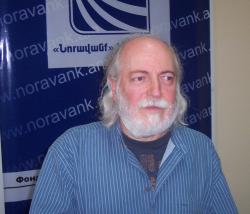NORAVANK LECTURINGS LEVON ABRAHAMIAN: “THE FOUR MODELS OF CONSOLIDATING”
 On October 31 in “Noravank” Foundation was delivered a lecture on the subject “The four models of consolidating national identity” (lectured by Levon Abrahamian: the ethnographer, head of the department of contemporary anthropological studies, Institute of Archeology & Ethnography, National Academy of Sciences of Armenia) in accordance with the “Noaravank” educational program on “Armenia and the Armenians in global developments: the present situation and challenges.”
On October 31 in “Noravank” Foundation was delivered a lecture on the subject “The four models of consolidating national identity” (lectured by Levon Abrahamian: the ethnographer, head of the department of contemporary anthropological studies, Institute of Archeology & Ethnography, National Academy of Sciences of Armenia) in accordance with the “Noaravank” educational program on “Armenia and the Armenians in global developments: the present situation and challenges.”
The identity of each nation has its peculiarities, which are the outcome of synthesizing and assembling this or that historical, cultural or philosophic factors. However, as Levon Abrahamyan said, according to recognition and appreciation of its own past and national values, one can single out four main models of consolidating national identity: “selective,” “historical,” “prestigious,” and “all-eating.” Of course, these models are not expressed absolutely with any nation, and the real picture is usually the result of combining the four, although, by this reason or that, one of the four models is more eye-striking.
Thus, for example, the models may be called “Russian,” “Armenian,” “Georgian” and “Azerbaijani” accordingly. Of course these names are conditional and express the identity consolidating models as precisely as various anecdotes characterize national identity according to the conduct of the representatives of the very nation.
“Selective” or “Russian” model has a tendency to get rid of all the foreigners in its surrounding; however, it doesn’t seem to see any foreigner even in the past. If a nation’s history is presented through the picture of a tree (genealogical schemes are often presented by such genealogical trees), than the “Russian” model cuts away the foreign branches from the upper part of the tree’s trunk – in the leafy part, whereas, it preserves and glorifies all the roots and branches in the lower part of the trunk, even if they are obvious to be foreign grafts done in its time. Moreover, those very foreign branches are sometimes considered to be the real national. L. Abrahamyan proved what he said by the example of Pushkin whose African origin doesn’t hinder him to be the greatest of all Russian poets. In the Russian Culture Pushkin is one of the rare examples whose even racial difference doesn’t make him foreign, this question is not even discussed, whereas the origin of the ones studying Pushkin may become a subject of discussion.
“Historical” or “Armenian” model as well as the “Russian” one struggle against “foreigners,” however, that struggle, in comparison with the “Russian” model, takes place in the far past, in the lowest part of the genealogical tree. If the Russian don’t see the foreigners at the root of their genealogical tree, the Armenians realize quite well the foreign origin of those roots and try to make them Armenian. If the “Russian” model “gets rid” of foreign branches by cutting them away, then the “Armenian” one considers them to be its own. L. Abrahamian made this thesis more precise by the observation of the problem of Urartu-Armenia correlation.
“Prestigious” or “Georgian” model, as well as the “Armenian” one, is only interested in the rooted part of the genealogical tree. However, in comparison with the “historical” model, it doesn’t avoid of foreign ancestor-roots and branches: on the contrary, it aspires to acquire the most prestigious (unique in its kind, the only one) national ancestor. The “Georgian” model looks for a prestigious ancestor in the field of ethnogeny. In the list of unique ancestor one can find Shumers, Urartians and even Basks. The speaker attracted everybody’s attention to the last version, especially because it is a better known one.
In the “Georgian” model the existence of “prestigious” ancestors doesn’t pursue political goals; however, its flexibility in ethno-genetic issues provides a chance to implement it quite successfully to solve political problems. This quality is very well expressed in the fourth “all eating” model of identity consolidation, which may also be called “Azerbaijani.” If the three models mentioned aspire to use the appropriation placing the foreigners only on the lower part of the genealogical tree, then the “all eating” model does it in all the parts of the tree. L. Abrahamian elucidated this model by the example of some aspects of the content of history textbooks published in Azerbaijan.
At the discussion following the lecture were spoken about different manifestations of the models, and a special stress was put on the fact that in every nation the models are transformed by time undergoing situational changes and don’t always remain the same.


